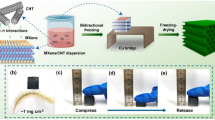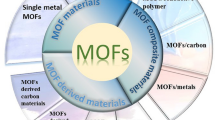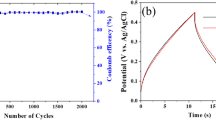Abstract
ZIF-8 is an excellent precursor or template for preparing nitrogen-doped porous carbon materials for supercapacitor electrodes. However, the porous carbon materials obtained by direct high-temperature carbonization of ZIF-8 have limited specific surface area and only microporous structure. These inhibit the electrolyte penetration and ion diffusion, which seriously affecting their electrochemical performance. In this work, nano-polyhedron nitrogen-doped porous carbon materials are prepared as electrode materials by a simple one-step heat treatment of ZIF-8 and polyvinylpyrrolidone complexes, and the effects of carbonization temperature and the content of polyvinylpyrrolidone are investigated for their capacitive performance. The introduction of polyvinylpyrrolidone in the ZIF-8 frame not only provides carbon and nitrogen sources, but also can effectively increase the specific surface area and optimizes pore size distribution after carbonization. Electrochemical tests show that the reversible specific capacitance is 296 F g−1 at the current density is 0.5 A g−1, and the capacity retention rate is 76% at 5 A g−1. Therefore, this work provides a new idea for exploring carbon material with excellent electrochemical properties for application in the field of supercapacitors.







Similar content being viewed by others
Data availability
The data of this study are available from the corresponding author upon reasonable request.
References
R. Fuller, P.J. Landrigan, K. Balakrishnan, G. Bathan, S. Bose-O’Reilly, M. Brauer, J. Caravanos, T. Chiles, A. Cohen, L. Corra, Pollution and health: a progress update. Lancet Planet. Health 6, e535 (2022)
H. Wang, Y. Yang, L. Guo, Nature-inspired electrochemical energy-storage materials and devices. Adv. Energy Mater. 7(5), 1601709 (2017)
Y. Wang, Y. Song, Y. Xia, Electrochemical capacitors: mechanism, materials, systems, characterization and applications. Chem. Soc. Rev. 45(21), 5925–5950 (2016)
P. Simon, Y. Gogotsi, Perspectives for electrochemical capacitors and related devices. Nat. Mater. 19(11), 1151–1163 (2020)
X. Li, B. Wei, Supercapacitors based on nanostructured carbon. Nano Energy 2(2), 159–173 (2013)
L.L. Zhang, X. Zhao, M.D. Stoller, Y. Zhu, H. Ji, S. Murali, Y. Wu, S. Perales, B. Clevenger, R.S. Ruoff, Highly conductive and porous activated reduced graphene oxide films for high-power supercapacitors. Nano Lett. 12(4), 1806–1812 (2012)
X. Wang, W. Zhang, Q. Zhou, F. Ran, Integrating supercapacitor with sodium hyaluronate based hydrogel as a novel all-in-one wound dressing: self-powered electronic stimulation. Chem. Eng. J. 452, 139491 (2023)
Z. Li, S. Gadipelli, H. Li, C.A. Howard, D.J. Brett, P.R. Shearing, Z. Guo, I.P. Parkin, F. Li, Tuning the interlayer spacing of graphene laminate films for efficient pore utilization towards compact capacitive energy storage. Nat. Energy 5(2), 160–168 (2020)
M.F. El-Kady, V. Strong, S. Dubin, R.B. Kaner, Laser scribing of high-performance and flexible graphene-based electrochemical capacitors. Science 335(6074), 1326–1330 (2012)
A. Leal, T. Pal, S. Rattan, M. Kaur, S. Kumar, J.K. Goswamy, Synergistic effect of reduced graphene oxide and carbon nanotubes for improved supercapacitive performance electrodes. J. Mater. Sci. 33(36), 26841–26851 (2022)
K. Li, S. Feng, C. Jing, Y. Chen, X. Liu, Y. Zhang, L. Zhou, Assembling a double shell on a diatomite skeleton ternary complex with conductive polypyrrole for the enhancement of supercapacitors. Chem. Commun. 55(91), 13773–13776 (2019)
K. Li, H. Teng, X. Dai, Y. Wang, D. Wang, X. Zhang, Y. Yao, X. Liu, L. Feng, J. Rao, Y. Zhang, Atomic scale modulation strategies and crystal phase transition of flower-like CoAl layered double hydroxides for supercapacitors. CrystEngComm 24(11), 2081–2088 (2022)
K. Li, H. Teng, Q. Sun, Y. Li, X. Wu, X. Dai, Y. Wang, S. Wang, Y. Zhang, K. Yao, Z. Bao, J. Rao, Y. Zhang, Engineering active sites on nitrogen-doped carbon nanotubes/cobaltosic oxide heterostructure embedded in biotemplate for high-performance supercapacitors. J. Energy Storage 53, 105094 (2022)
K. Li, C. Yin, X. Dai, J. Zhang, S. Yi, J. Rao, Y. Zhang, Facile synthesis and incomplete sulfidation of nickel-cobalt-aluminum ternary layered hydroxide binder-free electrode with enhanced supercapacitor properties. J. Energy Storage 55, 105722 (2022)
W. Zheng, J. Halim, P.O.Å. Persson, J. Rosen, M.W. Barsoum, MXene-based symmetric supercapacitors with high voltage and high energy density. Mater. Rep. 2(1), 100078 (2022)
S.I. Wong, H. Lin, T. Ma, J. Sunarso, B.T. Wong, B. Jia, Binary ionic liquid electrolyte design for ultrahigh-energy density graphene-based supercapacitors. Mater. Rep. 2(2), 100093 (2022)
Y. Peng, M. Yu, L. Zhao, H. Zeng, T. He, M.K. Hadi, R. Liu, G. Cao, H. Dang, Y. Wu, F. Ran, A 3D nano-sandwich structure constructed by intercalation of aramid nanofibers preventing re-stack of graphene for high surface area electrode materials. Appl. Surf. Sci. 612, 155903 (2023)
K. Li, Z. Guo, Q. Sun, X. Dai, Y. Li, K. Yao, X. Liu, Z. Bao, J. Rao, Y. Zhang, Phosphorus vacancy regulation and interfacial coupling of biotemplate derived CoP@FeP2 heterostructure to boost pseudocapacitive reaction kinetics. Chem. Eng. J. 454, 140223 (2023)
J. Yin, W. Zhang, N.A. Alhebshi, N. Salah, H.N. Alshareef, Synthesis strategies of porous carbon for supercapacitor applications. Small Methods 4(3), 1900853 (2020)
M. Zhou, S. Yan, Q. Wang, M. Tan, D. Wang, Z. Yu, S. Luo, Y. Zhang, X. Liu, Walnut septum-derived hierarchical porous carbon for ultra-high-performance supercapacitors. Rare Met. 41(7), 2280–2291 (2022)
Z. Wang, X. Zhang, X. Liu, Y. Zhang, W. Zhao, Y. Li, C. Qin, Z. Bakenov, High specific surface area bimodal porous carbon derived from biomass reed flowers for high performance lithium-sulfur batteries. J. Colloid Interface Sci. 569, 22–33 (2020)
H. Fan, F. Ran, X. Zhang, H. Song, W. Jing, K. Shen, L. Kong, L. Kang, A hierarchical porous carbon membrane from polyacrylonitrile/polyvinylpyrrolidone blending membranes: Preparation, characterization and electrochemical capacitive performance. J. Energy Chem. 23(6), 684–693 (2014)
Y. Liu, L. Si, X. Zhou, X. Liu, Y. Xu, J. Bao, Z. Dai, A selenium-confined microporous carbon cathode for ultrastable lithium-selenium batteries. J. Mater. Chem. A 2(42), 17735–17739 (2014)
Y. Song, D. Zhou, Y. Wang, C. Wang, Y. Xia, Preparation of nitrogen-containing mesoporous carbons and their application in supercapacitors. New J. Chem. 37(6), 1768–1775 (2013)
S. Zhong, C. Zhan, D. Cao, Zeolitic imidazolate framework-derived nitrogen-doped porous carbons as high performance supercapacitor electrode materials. Carbon 85, 51–59 (2015)
X. Zhao, H. Zhao, T. Zhang, X. Yan, Y. Yuan, H. Zhang, H. Zhao, D. Zhang, G. Zhu, X. Yao, One-step synthesis of nitrogen-doped microporous carbon materials as metal-free electrocatalysts for oxygen reduction reaction. J. Mater. Chem. A 2(30), 11666–11671 (2014)
S.L. Candelaria, B.B. Garcia, D. Liu, G. Cao, Nitrogen modification of highly porous carbon for improved supercapacitor performance. J. Mater. Chem. 22(19), 9884–9889 (2012)
S. Gadipelli, W. Travis, W. Zhou, Z. Guo, A thermally derived and optimized structure from ZIF-8 with giant enhancement in CO2 uptake. Energy Environ. Sci. 7(7), 2232–2238 (2014)
C. Lai, Z. Zhang, Y. Xu, J. Liao, Z. Xu, Z. Yi, J. Xu, J. Bao, X. Zhou, A general strategy for embedding ultrasmall CoMx nanocrystals (M=S, O, Se, and Te) in hierarchical porous carbon nanofibers for high-performance potassium storage. J. Mater. Chem. A 9(3), 1487–1494 (2021)
M. Qiao, Y. Wang, Q. Wang, G. Hu, X. Mamat, S. Zhang, S. Wang, Hierarchically ordered porous carbon with atomically dispersed FeN4 for ultraefficient oxygen reduction reaction in proton-exchange membrane fuel cells. Angew. Chem. Int. Ed. 59(7), 2688–2694 (2020)
H. Jiang, B. Liu, Y. Lan, K. Kuratani, T. Akita, H. Shioyama, F. Zong, Q. Xu, From metal-organic framework to nanoporous carbon: toward a very high surface area and hydrogen uptake. J. Am. Chem. Soc. 133(31), 11854–11857 (2011)
Y. Wang, M. Qiao, X. Mamat, Nitrogen-doped macro-meso-micro hierarchical ordered porous carbon derived from ZIF-8 for boosting supercapacitor performance. Appl. Surf. Sci. 540, 148352 (2021)
M. Thomas, R. Illathvalappil, S. Kurungot, B.N. Nair, A.A.P. Mohamed, G.M. Anilkumar, T. Yamaguchi, U. Hareesh, Graphene oxide sheathed ZIF-8 microcrystals: engineered precursors of nitrogen-doped porous carbon for efficient oxygen reduction reaction (ORR) electrocatalysis. ACS Appl. Mater. Interfaces 8(43), 29373–29382 (2016)
H. Li, D. Fu, X.M. Zhang, G. Han, F. Zhang, Facile Preparation of varisized ZIF-8 and ZIF-8/polypyrrole composites for flexible solid-state supercapacitor. ChemistrySelect 2(25), 7530–7534 (2017)
L. Wan, E. Shamsaei, C.D. Easton, D. Yu, Y. Liang, X. Chen, Z. Abbasi, A. Akbari, X. Zhang, H. Wang, ZIF-8 derived nitrogen-doped porous carbon/carbon nanotube composite for high-performance supercapacitor. Carbon 121, 330–336 (2017)
C. Young, R.R. Salunkhe, J. Tang, C. Hu, M. Shahabuddin, E. Yanmaz, M.S.A. Hossain, J.H. Kim, Y. Yamauchi, Zeolitic imidazolate framework (ZIF-8) derived nanoporous carbon: the effect of carbonization temperature on the supercapacitor performance in an aqueous electrolyte. Phys. Chem. Chem. Phys. 18(42), 29308–29315 (2016)
L. Bai, X. Jiang, C. Wu, X. Gao, Y. Su, K. Ding, Z. Zhang, Nanoporous carbons prepared with ZIF-8 as a template and activation agent for supercapacitors. Mater. Lett. 223, 150–153 (2018)
X. Lai, R. Guo, C. Cui, E. Ren, H. Xiao, Q. Qin, S. Jiang, Y. Zhang, Co-N-codoped carbon/Co@Carbon cloth hybrid derived from ZIF-67 for the oxygen evolution reaction and supercapacitors. Energy Fuels 34(10), 13023–13031 (2020)
J. Wu, X. Zhang, F. Wei, Y. Sui, J. Qi, Controllable synthesis of ZIF-derived nano-hexahedron porous carbon for supercapacitor electrodes. Mater. Lett. 258, 126761 (2020)
L. Wang, C. Wang, H. Wang, X. Jiao, Y. Ouyang, X. Xia, W. Lei, Q. Hao, ZIF-8 nanocrystals derived N-doped carbon decorated graphene sheets for symmetric supercapacitors. Electrochim. Acta 289, 494–502 (2018)
W. Cai, R.K. Kankala, M. Xiao, N. Zhang, X. Zhang, Three-dimensional hollow N-doped ZIF-8-derived carbon@MnO2 composites for supercapacitors. Appl. Surf. Sci. 528, 146921 (2020)
D. Zhang, J. Zhang, M. Pan, Y. Wang, T. Sun, Necklace-like C-ZIF-8@MWCNTs fabricated by electrochemical deposition towards enhanced supercapacitor. J. Alloy. Compd. 853, 157368 (2021)
L. Yang, Y. Feng, D. Yu, J. Qiu, X. Zhang, D. Dong, J. Yao, Design of ZIF-based CNTs wrapped porous carbon with hierarchical pores as electrode materials for supercapacitors. J. Phys. Chem. Solids 125, 57–63 (2019)
D. Zhang, T. Qin, S. Wu, X. Guo, C. Wang, Q. Xiang, Nafion-assisted electrophoretic deposition of ZIF-8 derivative N-doped porous carbon coating as high-performance supercapacitor electrode. Mater. Lett. 323, 132579 (2022)
H. Gong, S. Bie, J. Zhang, X. Ke, X. Wang, J. Liang, N. Wu, Q. Zhang, C. Luo, Y. Jia, In situ construction of ZIF-67-derived hybrid tricobalt Tetraoxide@Carbon for supercapacitor. Nanomaterials (Basel) 12(9), 1571 (2022)
C. Ma, Y. Mo, L. Liu, Y. Yu, A. Chen, ZIF-derived mesoporous carbon materials prepared by activation via Na2SiO3 for supercapacitor. Chin. Chem. Lett. 32(4), 1485–1490 (2021)
Acknowledgements
This work was partly supported by the National Natural Science Foundation of China (51763014 and 52073133), Joint fund between Shenyang National Laboratory for Materials Science and State Key Laboratory of Advanced Processing and Recycling of Nonferrous Metals (18LHPY002), and the Program for Hongliu Distinguished Young Scholars in Lanzhou University of Technology.
Author information
Authors and Affiliations
Contributions
JN and ZW: Conceptualization, Writing, Original draft preparation, and Validation; XY: Data collection, Methodology; and FR: Reviewing, Editing, and Supervision.
Corresponding author
Ethics declarations
Competing interests
The authors declare that there are no conflicts of interest or competing interests in this enclosed manuscript.
Research involving human or animal participants
There is no human tissue being used in the experiment.
Additional information
Publisher's Note
Springer Nature remains neutral with regard to jurisdictional claims in published maps and institutional affiliations.
Supplementary Information
Below is the link to the electronic supplementary material.
Rights and permissions
Springer Nature or its licensor (e.g. a society or other partner) holds exclusive rights to this article under a publishing agreement with the author(s) or other rightsholder(s); author self-archiving of the accepted manuscript version of this article is solely governed by the terms of such publishing agreement and applicable law.
About this article
Cite this article
Niu, J., Wang, Z., Wang, X. et al. Zeolitic imidazolate frameworks derived carbon with rational porous structure mediated by polyvinylpyrrolidone applied as electrode materials for supercapacitors. J Mater Sci: Mater Electron 34, 721 (2023). https://doi.org/10.1007/s10854-023-09994-4
Received:
Accepted:
Published:
DOI: https://doi.org/10.1007/s10854-023-09994-4




